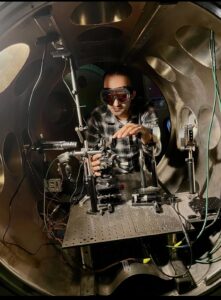Research
Transport in High Energy Density Flows
 The dynamic properties of fluids and plasmas in extreme environments (pressures exceeding millions of atmospheres) related to astrophysics, planetary formation, and fusion sciences are not well-described. Part of the challenge is because such environments are difficult to produce and study at laboratory scale, and as a result, simulations rely heavily on our understanding of flow physics in “normal” environments. Even when these states are attained, they last for only a few nanoseconds. One of our objectives is to develop implicit methods to measure fundamental transport properties such as dynamic viscosity at these conditions, where there is a gap in both experimental measurements and in theoretical predictions. Our work is conducted at “big science” facilities like the Laboratory for Laser Energetics, LLNL Jupiter Laser Facility, and Stanford Linear Accelerator Center.
The dynamic properties of fluids and plasmas in extreme environments (pressures exceeding millions of atmospheres) related to astrophysics, planetary formation, and fusion sciences are not well-described. Part of the challenge is because such environments are difficult to produce and study at laboratory scale, and as a result, simulations rely heavily on our understanding of flow physics in “normal” environments. Even when these states are attained, they last for only a few nanoseconds. One of our objectives is to develop implicit methods to measure fundamental transport properties such as dynamic viscosity at these conditions, where there is a gap in both experimental measurements and in theoretical predictions. Our work is conducted at “big science” facilities like the Laboratory for Laser Energetics, LLNL Jupiter Laser Facility, and Stanford Linear Accelerator Center.
Department of Energy Office of Fusion Energy Sciences
National Nuclear Security Administration Stewardship Sciences Academic Alliances
National Science Foundation
Center for Matter at Atomic Pressures
The Laboratory for Laser Energetics Laboratory Basic Sciences Program
Grads: Na’im Kalantar, Nitish Acharya, Afreen Syeda, Kelin Kurzer-Ogul, Hao Yin
Undergrads: Jerome Yau
University of Rochester / LLE: Hussein Aluie, Riccardo Betti, J. Ryan Rygg, Danae Polsin, Rip Collins
SLAC: Arianna Gleason, Josh Turner
Oxford: Gianluca Gregori
LANL: Brian Haines, Josh Sauppe, David Montgomery
LLNL: Peter Celliers, Gaia Righi, Hye-Sook Park
Biologically-Inspired Sensing
Many animals use mechanical stimuli to understand their environments. One such remarkable animal is the harbor seal (and other seal species); the seal can rely entirely on the feedback from their whiskers to follow prey or other wake signatures. Their whiskers are especially adapted to feel fluctuations in the flow that would indicate that there is something of interest, and where it’s coming from. In this project, we are trying to mimic this in the lab by developing our own whisker-like sensors that similarly use hydrodynamic feedback to differentiate between various objects (fish? rock?) that are nearby. Ultimately, we would like to integrate these sensors into underwater robotic platforms.
Office of Naval Research
Grads: Sandhya Vaidyanathan
Undergrads: Sam Scheinbach, Sophia Fabian
Rochester Institute of Technology: Xudong Zheng, Qian Xue, Qi Yu
Clearance Pathways in the Brain
Metabolic waste in the brain is evacuated via a network paravascular spaces transporting cerebrospinal fluid. This clearance process is most active during sleep, and the buildup of the waste is linked to neurodegenerative diseases such as Alzheimer’s. In our work, we seek to shed light on mechanisms that drive the flow, using a computational approach informed by in vivo measurements.
National Science Foundation (CBET Division)
Past: National Institute of Aging
Postdocs: Kiera Harmatz-Kean
Grads: Biraj Khadka
Kim Boster
Maiken Nedergaard
Doug Kelley
Jack Thomas
Past Projects
These projects are currently inactive or on hiatus. If you are interested in supporting this work, please get in touch.

Infants born with single ventricle defects undergo a series of 3 surgical procedures beginning shortly after birth. The first stage, a systemic-pulmonary shunt, has the highest mortality of the three. The second stage, the Bidirectional Glenn, should provide a better circulation than the first stage, but has led to extremely high mortality among neonates. Through virtual surgeries and numerical simulation, we are investigating the Assisted Bidirectional Glenn (ABG) — a modification to the Glenn — as a viable procedure for neonates. This work was previously performed with the Stanford Cardiovascular Biomechanics Computation Lab.

Superhydrophobic (non-wetting) materials are abundant in nature and have a number of transport properties (e.g., icephobic, omniphobic, anti-fouling, drag-reducing) that can be harnessed into engineering materials for airplane wings, building materials, medical equipment, and so on. The non-wetting state, however, can be compromised by impinging droplets in the form of rain or chemical sprays. Our lab is interested in characterizing dynamic droplet phenomena on these surfaces to gain insight on how to develop improved surfaces that are robust for the desired application.

While many animals are able to navigate multiple media — water, air, land — with reasonable deftness, we struggle to impart the same ability to autonomous vehicles. We are adapting a mechanism that works well in moving over sand and water to be able to cover complex media that occurs in the sand-water transition, and studying how this propulsive mechanism produces thrust differently from conventional engineered propulsors or biologically-inspired ones. Elements of this work are in collaboration with Hesam Askari, Alice Quillen, Scott Seidman, and Randal Nelson, with whom we share a seed grant (University Research Award). This research is also partially supported by ONR.
